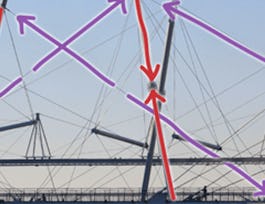The "Robotics Engineering & Applications" course stands as a beacon of innovation and opportunity in the realm of collaborative robotics. Comprising three dynamic modules, participants embark on a transformative journey delving into the essentials of robotic engineering, advanced programming techniques, and the integration of vision systems in designing and building robots for real-world applications. This course is meticulously crafted to cater to the diverse learning needs of undergraduate students of Mechanical & Mechatronics Engineering, students specializing in robotics & automation, post-graduate students of Mechanical Engineering & Computer-Aided Manufacturing Engineering, as well as practicing engineers in automation environments.



Robotics Engineering & Applications
This course is part of Collaborative Robotics in Industry Specialization

Instructor: Subject Matter Expert
Sponsored by Coursera Learning Team
1,816 already enrolled
(17 reviews)
Recommended experience
Details to know

Add to your LinkedIn profile
3 assignments
See how employees at top companies are mastering in-demand skills

Build your subject-matter expertise
- Learn new concepts from industry experts
- Gain a foundational understanding of a subject or tool
- Develop job-relevant skills with hands-on projects
- Earn a shareable career certificate


Earn a career certificate
Add this credential to your LinkedIn profile, resume, or CV
Share it on social media and in your performance review

There are 3 modules in this course
Robotic Engineering and Automation integrate mechanical, electrical, and computer engineering to develop intelligent systems, enhancing efficiency and safety in industries. Industrial robots, equipped with programmable control systems, perform tasks with precision and consistency, organized with meticulous arrangement of components for optimal performance and adaptability. Understanding robotic configurations, kinematics, and dynamics guides the selection and design process, ensuring effective task execution and spatial manipulation capabilities.
What's included
17 videos1 assignment
Robot programming methods, including teach pendant, offline simulation, and script-based programming, offer flexibility and efficiency in task deployment, involving motion path definition and end-effector configuration. Evolution in programming techniques, supported by standardized languages like ROS and RAPID, ensures seamless integration and adaptability, illustrated through collaborative Robot programming and practical vision system applications for enhanced perception and decision-making in diverse industries.
What's included
18 videos1 assignment
Robot design involves meticulous consideration of criteria such as payload capacity, reach, speed, and precision, with iterative testing and optimization ensuring efficiency and reliability. End effectors, critical for functionality, must align with task requirements and the robot's capabilities, emphasizing adaptability and specific application needs. Integration of IoT enhances connectivity and data exchange, optimizing decision-making processes and promoting efficiency in robotic applications.
What's included
16 videos1 assignment
Instructor

Offered by
Why people choose Coursera for their career




Recommended if you're interested in Physical Science and Engineering

Board Infinity

Automation Anywhere

Dartmouth College

Open new doors with Coursera Plus
Unlimited access to 10,000+ world-class courses, hands-on projects, and job-ready certificate programs - all included in your subscription
Advance your career with an online degree
Earn a degree from world-class universities - 100% online
Join over 3,400 global companies that choose Coursera for Business
Upskill your employees to excel in the digital economy



